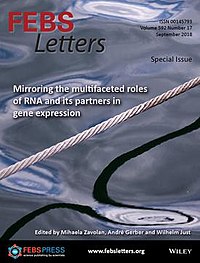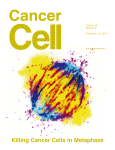
Cancer Cell is a peer-reviewed scientific journal scientific journal that publishes articles that provide major advances in cancer research and oncology. The journal considers manuscripts that answer important questions relevant to naturally occurring cancers. Areas covered include basic cancer biology, therapeutic development, translational research, cancer model development, multi-omics and computational biology. Cancer Cell is also interested in publishing clinical investigations, in particular those that lead to establishing new paradigms in the treatment, diagnosis, or prevention of cancers; those that provide important insights into cancer biology beyond what has been revealed by preclinical studies; and those that are mechanism-based proof-of-principle clinical studies.
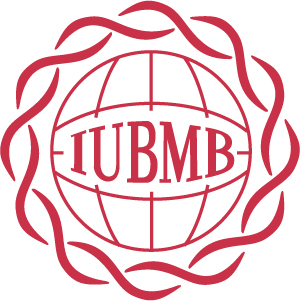
The International Union of Biochemistry and Molecular Biology (IUBMB) is an international non-governmental organisation concerned with biochemistry and molecular biology. Formed in 1955 as the International Union of Biochemistry (IUB), the union has presently 79 member countries and regions (as of 2020). The Union is devoted to promoting research and education in biochemistry and molecular biology throughout the world, and gives particular attention to localities where the subject is still in its early development.

The Journal of Biological Chemistry (JBC) is a weekly peer-reviewed scientific journal that was established in 1905. Since 1925, it is published by the American Society for Biochemistry and Molecular Biology. It covers research in areas of biochemistry and molecular biology. The editor is Alex Toker. As of January 2021, the journal is fully open access. In press articles are available free on its website immediately after acceptance.

Complement C1r subcomponent is a protein involved in the complement system of the innate immune system. In humans, C1r is encoded by the C1R gene.
Tissue kallikrein is an enzyme. This enzyme catalyses the following chemical reaction
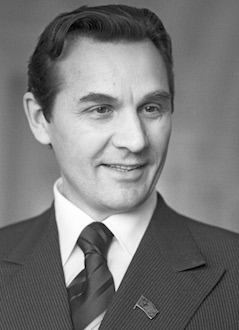
Yuri Anatolievich Ovchinnikov was a Soviet bioorganic chemist. He was elected in 1970 as a full member of the USSR Academy of Sciences and subsequently became the youngest vice president of the academy in its history (1974-1988). He was elected to the American Philosophical Society in 1977. He was also president of the Federation of European Biochemical Societies (1984-1986), Director of the Institute of Bioorganic Chemistry in Moscow (1970-1988) and professor at Moscow State University. From 1972 through to 1984 he served concomitantly as head of the Laboratory of Protein Chemistry at the USSR Academy of Sciences' Institute of Protein.

Actin, alpha skeletal muscle is a protein that in humans is encoded by the ACTA1 gene.

Cathepsin L1 is a protein that in humans is encoded by the CTSL1 gene. The protein is a cysteine cathepsin, a lysosomal cysteine protease that plays a major role in intracellular protein catabolism.

Potassium voltage-gated channel, shaker-related subfamily, member 5, also known as KCNA5 or Kv1.5, is a protein that in humans is encoded by the KCNA5 gene.

Neuroendocrine protein 7B2 is a protein that in humans is encoded by the SCG5 gene. The protein expressed by this gene is widely distributed in neuroendocrine tissues. It functions as a chaperone protein for the proprotein convertase PC2 by blocking the aggregation of this protein, and is required for the production of an active PC2 enzyme. It is an intrinsically disordered protein that may also function as a chaperone for other aggregating secretory proteins in addition to proPC2. 7B2 has been identified in vertebrates and in invertebrates as low as flatworms and insects. It is also called Sgne1 and Secretogranin V. In C. elegans, it was originally called e7B2 and then renamed Seven B Two. There is a Pfam entry for this protein: Secretogranin_V (PF05281).

Rnd1 is a small signaling G protein, and is a member of the Rnd subgroup of the Rho family of GTPases. It is encoded by the gene RND1.

Eukaryotic translation initiation factor 4E type 2 is a protein that in humans is encoded by the EIF4E2 gene. It belongs to the eukaryotic translation initiation factor 4E family.
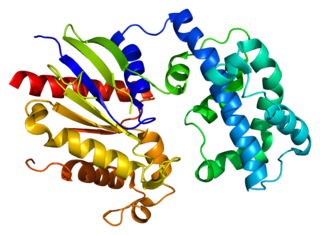
Guanine nucleotide-binding protein subunit alpha-13 is a protein that in humans is encoded by the GNA13 gene.

Annual Review of Biochemistry is an annual peer-reviewed scientific journal published by Annual Reviews, a nonprofit scientific publisher. Its first volume was published in 1932, and its founding editor was J. Murray Luck. The current editor is Roger D. Kornberg. The journal focuses on molecular biology and biological chemistry review articles. As of 2023, Journal Citation Reports gives the journal an impact factor of 16.6, ranking it seventh out of 285 journals in the category "Biochemistry and Molecular Biology". As of 2023, it is being published as open access, under the Subscribe to Open model.

Ecadotril is a neutral endopeptidase inhibitor ((NEP) EC 3.4.24.11) and determined by the presence of peptidase family M13 as a neutral endopeptidase inhibited by phosphoramidon. Ecadotril is the (S)-enantiomer of racecadotril. NEP-like enzymes include the endothelin-converting enzymes. The peptidase M13 family believed to activate or inactivate oligopeptide (pro)-hormones such as opioid peptides, neprilysin is another member of this group, in the case of the metallopeptidases and aspartic, the nucleophiles clan or family for example MA, is an activated water molecule. The peptidase domain for members of this family also contains a bacterial member and resembles that of thermolysin the predicted active site residues for members of this family and thermolysin occur in the motif HEXXH. Thermolysin complexed with the inhibitor (S)-thiorphan are isomeric thiol-containing inhibitors of endopeptidase EC 24-11 (also called "enkephalinase").

Momordin or α-momorcharin is one of several related proteins isolated from several plants of the genus Momordica, which includes the bitter melon and the balsam apple.
Geraniol 8-hydroxylase (EC 1.14.14.83, Formerly EC 1.14.13.152, CYP76B6, G10H, CrG10H, SmG10H) is an enzyme with systematic name geraniol,NADPH:oxygen oxidoreductase (8-hydroxylating). This enzyme catalyses the following chemical reaction
Avadhesha Surolia is a glycobiologist at the Indian Institute of Science (IISc), Bangalore. He was born in Kishangarh, Rajasthan, India. Presently, he is an honorary professor at the Molecular Biophysics Unit, IISc and holds the Bhatnagar fellowship of the Council of Scientific and Industrial Research (CSIR). He is known for his work on lectin structure and interactions, orientation and dynamics of cell surface carbohydrate receptors and protein folding, diabetes, antimalarials and anti-cancer agents based on curcumin, flavonoids, etc. In addition, neuropathic pain, neurodegenerative disorders and the link between immunity and obsessive–compulsive disorder are areas of his current interest
William Joseph Whelan FRS was a British-born American biochemist. He was professor and chair of biochemistry and molecular biology at the Leonard M. Miller School of Medicine of the University of Miami. He founded the annual Miami Winter Symposium in 1967 and was chief editor of the journal IUBMB Life.

Athel Cornish-Bowden is a British biochemist known for his numerous textbooks, particularly those on enzyme kinetics and his work on metabolic control analysis.
